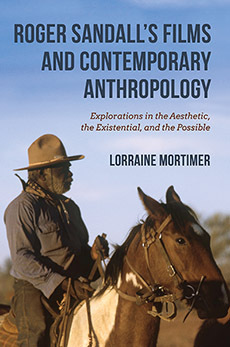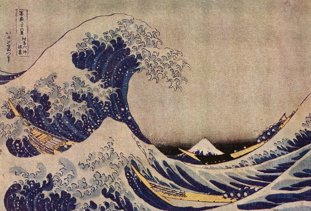 The trouble with the sea is it’s so BIG. Artists sensitive to this fact, and with only modest egos, generally do what Hokusai did in The Hollow of the Deep Sea Wave off Kanagawa. They give Neptune his due. The wave with its curious talons is seen higher than Mt Fuji, while the fishermen in their boats below are tiny and cowering—you have to look hard to find them. This was a landscape tradition showing insignificant men and women dwarfed by mountains, sea, and sky. Man is nothing. Nature is all.
The trouble with the sea is it’s so BIG. Artists sensitive to this fact, and with only modest egos, generally do what Hokusai did in The Hollow of the Deep Sea Wave off Kanagawa. They give Neptune his due. The wave with its curious talons is seen higher than Mt Fuji, while the fishermen in their boats below are tiny and cowering—you have to look hard to find them. This was a landscape tradition showing insignificant men and women dwarfed by mountains, sea, and sky. Man is nothing. Nature is all.
Today a more heroic tradition prevails. An artist with ego is just as likely to regard the sea as a challenge. No sooner does he find a wave than he has to ride it—figuratively speaking at least. And if some well-endowed arts committee invites works for a sculpture competition on a prominent headland beside the ocean he feels obliged to show how clever he is; how unintimidated by Neptune; how with a bit of engineering skill, and by flexing his artistic muscles, Man can upstage Nature any time.
For a big setting, a big work, with all the nuts and bolts and couplings scaffolding needs. 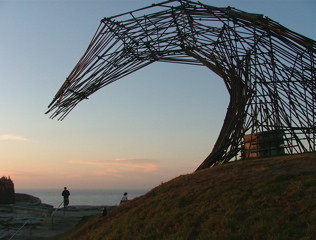 Lots of art today is showmanship, and since thousands of visitors to Bondi’s annual exhibition paused to stare wonderingly up at the skeletal maze poised perilously above them, from that point of view Jarrod Taylor’s “Structural Wave” was a success. It loomed and threatened. Unlike Hokusai’s message, Taylor sounded as if he were saying to both nature and gravity: You are nothing. I am all.
Lots of art today is showmanship, and since thousands of visitors to Bondi’s annual exhibition paused to stare wonderingly up at the skeletal maze poised perilously above them, from that point of view Jarrod Taylor’s “Structural Wave” was a success. It loomed and threatened. Unlike Hokusai’s message, Taylor sounded as if he were saying to both nature and gravity: You are nothing. I am all.
 There was also a giant deck chair, a giant fried egg, giant limpets, giant goldfish, and a giant sea urchin looking as if it was about to take over the world. Hypertrophy here seems to have had a variety of motives—most of them frivolous, and all pointing to the fact that without a huge increase in scale no-one would even notice the artist’s work. “Recliner Rex” and “Big Chook” are jokes. But since much cultural performance today takes itself rather too seriously there’s certainly a place for humor here and there.
There was also a giant deck chair, a giant fried egg, giant limpets, giant goldfish, and a giant sea urchin looking as if it was about to take over the world. Hypertrophy here seems to have had a variety of motives—most of them frivolous, and all pointing to the fact that without a huge increase in scale no-one would even notice the artist’s work. “Recliner Rex” and “Big Chook” are jokes. But since much cultural performance today takes itself rather too seriously there’s certainly a place for humor here and there.
This is especially so when textual glosses by the sculptors themselves tell us how Artist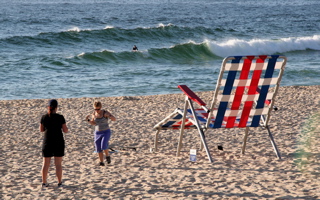 1 wants to “question our attitudes toward death”, or how the work of Artist 2 “references Alex Seton’s iconic limestone faces to explore the ongoing relationship between a sculpture and a space.” Though I feel such utterances should be kindly treated. On the one hand because few artists seem to have ‘an ongoing relationship’ with language (or not with prose); on the other because what they say often mimics the derelict nonsense written by professors of Fine Arts.
1 wants to “question our attitudes toward death”, or how the work of Artist 2 “references Alex Seton’s iconic limestone faces to explore the ongoing relationship between a sculpture and a space.” Though I feel such utterances should be kindly treated. On the one hand because few artists seem to have ‘an ongoing relationship’ with language (or not with prose); on the other because what they say often mimics the derelict nonsense written by professors of Fine Arts.
* * *
Historically, monumental sculpture has always been associated with despotic excess: political megalomania and hypertrophic art went hand in hand. This was strikingly so in Egypt long before Mt Rushmore came along—and Borglum’s work is an anomaly. For the most part the impulse to erect colossal images of political leaders is alien to both the European peoples and the democratic tradition—where the cost is borne by citizens who want to know why. In this connection it is noteworthy that inside even the tallest European cathedrals the religious statuary is of generally human scale.
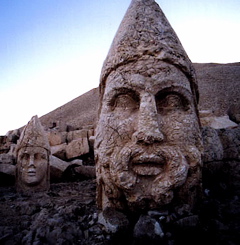 Elsewhere, however, especially east of the Mediterranean, huge images of kings and gods have been a feature for thousands of years. The giant heads atop Anatolia’s Mount Nemrud, all that remains of statues 20 to 30 feet high built by King Antiochus of Commagene, are the most revealing—the pure essence of oriental despotism in stone; those on Easter Island are the most mysterious; those erected under Stalin the most haunted by terror and dread.
Elsewhere, however, especially east of the Mediterranean, huge images of kings and gods have been a feature for thousands of years. The giant heads atop Anatolia’s Mount Nemrud, all that remains of statues 20 to 30 feet high built by King Antiochus of Commagene, are the most revealing—the pure essence of oriental despotism in stone; those on Easter Island are the most mysterious; those erected under Stalin the most haunted by terror and dread.
For the grossest example of artistic megalomania in recent times—an example combining showmanship and sheer imperial ambition—one need look no further than the perversities of Christo. At the time of his saffron takeover of Central Park earlier this year he was said to have “caused a buzz on four continents” — and that’s a bigger empire than King Antiochus ever ruled. Sad to say, his influence on those who feel a need to wrap things lingers: the same pitiful ambition was displayed at Bondi.
 Sandstone cliff randomly patterned by wind and sea is a delight enjoyed (and much photographed) by walkers and joggers and visitors of every kind. To anyone aware of natural form and color it’s a miracle of unintelligent design. Especially remarkable is a large and isolated rock along the way. So what should be done? Preferably of course nothing at all. But this was an outing for artists—including one who hadn’t heard that Christo has moved on to other things—so it was promptly tied up in ugly orange rope. You turned your eyes away, surprised such an affront was even permitted, and hopefully gazed out at the healing waves.
Sandstone cliff randomly patterned by wind and sea is a delight enjoyed (and much photographed) by walkers and joggers and visitors of every kind. To anyone aware of natural form and color it’s a miracle of unintelligent design. Especially remarkable is a large and isolated rock along the way. So what should be done? Preferably of course nothing at all. But this was an outing for artists—including one who hadn’t heard that Christo has moved on to other things—so it was promptly tied up in ugly orange rope. You turned your eyes away, surprised such an affront was even permitted, and hopefully gazed out at the healing waves.
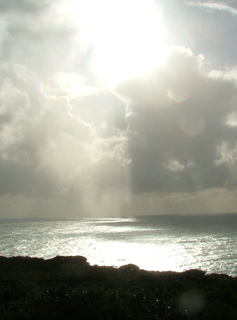 The poet Vachel Lindsay once said that even the worst photoplay could be redeemed by “noble views of the sea”. Perhaps an effect of this sort was in the minds of the organizers of this sculpture show too. Some of it did need redeeming, and one likes to imagine that redemption was the effect the ocean had. But noble views of the sea are just as likely to remind audiences of the strange ignobilities of the human scene as well.
The poet Vachel Lindsay once said that even the worst photoplay could be redeemed by “noble views of the sea”. Perhaps an effect of this sort was in the minds of the organizers of this sculpture show too. Some of it did need redeeming, and one likes to imagine that redemption was the effect the ocean had. But noble views of the sea are just as likely to remind audiences of the strange ignobilities of the human scene as well.
* * *
Today (apart from Christo) our interest in scale also has more innocent sources. It probably owes something to the intellectual world we now inhabit, a world newly aware of both the microscopic sub-universe (“there’s room at the bottom” said Richard Feynman once, foreseeing smaller and smaller iPods holding larger and larger files) and the macroscopic super-universe of the cosmos. Images from both micro and macro worlds are constantly before us, with bacteria on television vying for attention alongside beetles the size of dinosaurs, and dinosaurs alongside Jupiter’s remote and exotic moons. Once novel and revelatory, the Eames brothers’ Powers of Ten is how we now look at life.
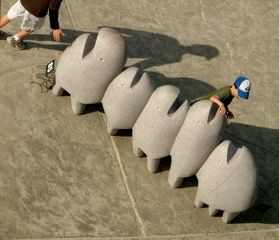 Koichi Ogino’s granite fish are my kind of thing. Strong shapes. Solid forms. Attractive texture. Not too naturalistic. Not too serious. Not trying to impress. No visible or audible message, and if the artist wants to remind us in his comments that we are all living things together… well, that is both unarguably true and fine by me. These are shapes that magnetically draw the passer-by, and hardly anyone could resist extending a friendly hand. Real fish are cold and slithery things and not fun to handle. Koichi’s granite fish probably did more to make these creatures from the sea appealing than hours of earnest environmental pleas. No child could resist them.
Koichi Ogino’s granite fish are my kind of thing. Strong shapes. Solid forms. Attractive texture. Not too naturalistic. Not too serious. Not trying to impress. No visible or audible message, and if the artist wants to remind us in his comments that we are all living things together… well, that is both unarguably true and fine by me. These are shapes that magnetically draw the passer-by, and hardly anyone could resist extending a friendly hand. Real fish are cold and slithery things and not fun to handle. Koichi’s granite fish probably did more to make these creatures from the sea appealing than hours of earnest environmental pleas. No child could resist them.
 The wooden sea urchin was more ambiguous—here gigantism again looms in a threatening way. From the top it looked harmless enough: the round shape was dominant, and children playing nearby gave the warm timber construction a friendly feel. But moving closer the outer form of a sea urchin was no longer seen. It resembled an enormous spider crouching to attack. It became all legs; arachnophobia whispered fearfully. ‘On the Staircase’ by the Danish artist Keld Moseholm is a playful bronze that faintly echoes Escher. Diminishing figures ascend diminishing stairs to oblivion.
The wooden sea urchin was more ambiguous—here gigantism again looms in a threatening way. From the top it looked harmless enough: the round shape was dominant, and children playing nearby gave the warm timber construction a friendly feel. But moving closer the outer form of a sea urchin was no longer seen. It resembled an enormous spider crouching to attack. It became all legs; arachnophobia whispered fearfully. ‘On the Staircase’ by the Danish artist Keld Moseholm is a playful bronze that faintly echoes Escher. Diminishing figures ascend diminishing stairs to oblivion.
* * *
 Bondi’s Sculpture by the Sea is part cultural event, part family entertainment. Men and women and children who wouldn’t normally visit galleries have a chance to see what passes for art in our time—and there’s plenty that’s passable enough. The setting near a popular beach ensures that if the kids don’t like sculpture then they can swim and play ball games instead. On a nice day in early summer the sun shines, the sea breeze blows, an amiable atmosphere prevails—encouraged by the whimsical intent of many pieces—and it would be foolish to take it all too seriously. For most visitors it’s an outing by the sea.
Bondi’s Sculpture by the Sea is part cultural event, part family entertainment. Men and women and children who wouldn’t normally visit galleries have a chance to see what passes for art in our time—and there’s plenty that’s passable enough. The setting near a popular beach ensures that if the kids don’t like sculpture then they can swim and play ball games instead. On a nice day in early summer the sun shines, the sea breeze blows, an amiable atmosphere prevails—encouraged by the whimsical intent of many pieces—and it would be foolish to take it all too seriously. For most visitors it’s an outing by the sea.
 Yet the problem raised by Vachel Lindsay’s observation remains. Perhaps “noble views of the sea” introduced into some negligible movie script are redeeming. Perhaps they can have the same effect on miscellaneous assembled sculptures too. But you can’t deny that the grandeur of sea and sky and coastline also puts humanity and its vaunted artefacts sharply in place. That’s how Hokusai saw things, I suspect, and I’m inclined to think Hokusai was right.
Yet the problem raised by Vachel Lindsay’s observation remains. Perhaps “noble views of the sea” introduced into some negligible movie script are redeeming. Perhaps they can have the same effect on miscellaneous assembled sculptures too. But you can’t deny that the grandeur of sea and sky and coastline also puts humanity and its vaunted artefacts sharply in place. That’s how Hokusai saw things, I suspect, and I’m inclined to think Hokusai was right.
Bondi Beach

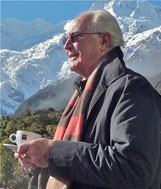 An Australian writer living in Sydney, Roger Sandall is the author of The Culture Cult (2001), a study of romantic primitivism and its effects. His work has appeared in a number of places including Commentary, The American Interest, Encounter, The New Criterion, The American, Sight and Sound, Quadrant, Art International, The New Lugano Review, The Salisbury Review, Merkur, Mankind, Visual Anthropology, and Social Science and Modern Society.
An Australian writer living in Sydney, Roger Sandall is the author of The Culture Cult (2001), a study of romantic primitivism and its effects. His work has appeared in a number of places including Commentary, The American Interest, Encounter, The New Criterion, The American, Sight and Sound, Quadrant, Art International, The New Lugano Review, The Salisbury Review, Merkur, Mankind, Visual Anthropology, and Social Science and Modern Society.